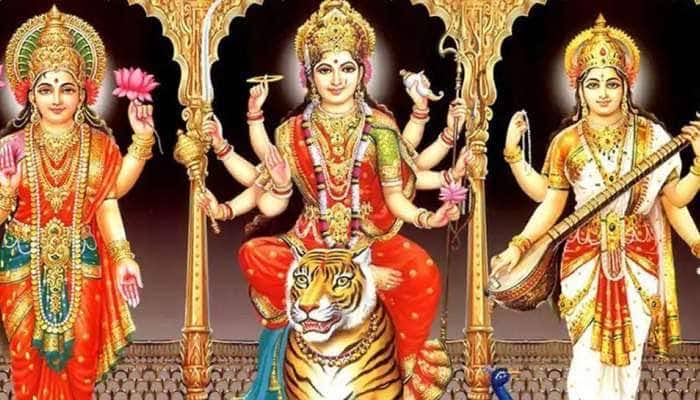
#மகாபெரியவா #நவராத்திரியில் பராசக்தியான துர்கா பரமேசுவரியையும், மகாலக்ஷ்மியையும், ஸரஸ்வதி தேவியையும் பூஜிக்கிறோம். மூன்று மூர்த்திகளாகச் சொன்னாலும், முப்பத்து முக்கோடி மூர்த்திகளாகச் சொன்னாலும், அத்தனையாகவும் இருப்பது ஒரே பராசக்திதான். இந்த உண்மையைத்தான் லலிதா ஸஹஸ்ரநாமம் 

பரதேவதைய வர்ணிக்கும்போது அவளே சிருஷ்டி செய்பவள் (ஸ்ருஷ்டிகர்த்ரீ – ப்ரஹ்ம ரூபா) அவளே பரிபாலனம் செய்பவள் (கோப்த்ரீ – கோவிந்த ரூபிணீ), அவளே சம்ஹாரம் செய்பவள் (ஸம்ஹாரிணீ – ருத்ரரூபா) என்று சொல்கிறது. லலிதையாக, துர்க்கையாக இருக்கிற பராசக்திதான் மஹாலக்ஷ்மியாகவும், ஸரஸ்வதியாகவும்
இருக்கிறது. லக்ஷ்மி அஷ்டோத்தரத்தில் ‘பிரம்ம விஷ்ணு சிவாத்மிகாயை நம:’ என்று வருகிறது. ஸரஸ்வதி அஷ்டோத்தரத்திலும் இப்படியே ‘பிரம்ம விஷ்ணு சிவாத்மிகாயை நம:’ என்று வருகிறது. படைப்பு, அழிப்பு, காப்பு எல்லாம் செய்வது ஒரே சக்திதான் என்று இந்த நாமங்கள் நமக்கு நன்றாக உணர்த்துகின்றன. ஒரே
பராசக்தி தான் வெவ்வேறு வேஷங்களைப் போட்டுக்கொண்டு வெவ்வேறு காரியங்களைச் செய்கிறது. துர்க்கையாக இருக்கிறபோது, வீரம், சக்தி எல்லாம் தருகிறது. மஹாலக்ஷ்மியாகி சம்பத்துக்களைத் தருகிறது. ஸரஸ்வதியாகி ஞானம் தருகிறது. ஆதிபராசக்தியான துர்க்கையைப் பொதுவாகப் பார்வதியோடு ஐக்கியப்படுத்திச்
சொல்லலாம். அவள் ஹிமவானின் புத்திரியானதால் மலைமகள். மஹாலக்ஷ்மி பாற்கடலில் தோன்றியதால் அலைமகள். ஸரஸ்வதி சகலகலா ஞானமும் தருவதால் கலைமகள்.
பர்வதராஜ புத்திரியாக வந்த அம்பாளும், க்ஷீரசாகரத்திலிருந்து பிறந்த மஹாலக்ஷ்மியும், இரண்டு மஹரிஷிகளுக்குப் பெண்களாகவும் அவதரித்திருக்கிறார்கள்.
மஹா
பர்வதராஜ புத்திரியாக வந்த அம்பாளும், க்ஷீரசாகரத்திலிருந்து பிறந்த மஹாலக்ஷ்மியும், இரண்டு மஹரிஷிகளுக்குப் பெண்களாகவும் அவதரித்திருக்கிறார்கள்.
மஹா
லக்ஷ்மியை மகளாகப் பெற்று, சீராட்டி வளர்க்க வேண்டும் என்று பிருகு மஹரிஷி தபஸ் செய்தார். அதற்கிணங்கவே லக்ஷ்மிதேவி அவருக்குப் புத்திரியாக உத்பவித்தாள். பிருகுவுக்குப் புத்திரியானதால் அவளுக்கு பார்கவி என்று பெயர் ஏற்பட்டது.
‘பார்கவி லோக ஜனனி க்ஷீரஸாகர கன்யகா’ எனறு ஸம்ஸ்கிருத
‘பார்கவி லோக ஜனனி க்ஷீரஸாகர கன்யகா’ எனறு ஸம்ஸ்கிருத
அகராதியான ‘அமர கோசம்’ சொல்லும். இப்படியே காத்யாயன மகரிஷி சாக்ஷாத் பரமேசுவரியைப் பெண்ணாக அடைய வேண்டும் என்று விரும்பித் தபஸ் செய்தார். அம்பிகையும் அவருக்கு மகளாக ஆவிர்பவித்தாள். காத்யாயனருக்குப் பெண் என்பதாலேயே அவளுக்குக் காத்யாயனி என்ற பெயர் உண்டாயிற்று. துர்க்கைக்கு உரிய
காயத்ரியிலே அவளைக் ‘காத்யாயனியாக தியானிக்கிறோம்’ என்று சொல்லியிருக்கிறது.
லோக மாதாக்களாக இருக்கப்பட்ட தெய்வங்களைக் குழந்தையாக வரச் சொன்னதில் நிரம்ப விசேஷம் இருக்கிறது. ‘குழந்தையும் தெய்வமும் கொண்டாடும் இடத்திலே’ என்கிறோம். தெய்வமே குழந்தையாக வந்தால், ரொம்பக் கொண்டாட்டமாகும்.
லோக மாதாக்களாக இருக்கப்பட்ட தெய்வங்களைக் குழந்தையாக வரச் சொன்னதில் நிரம்ப விசேஷம் இருக்கிறது. ‘குழந்தையும் தெய்வமும் கொண்டாடும் இடத்திலே’ என்கிறோம். தெய்வமே குழந்தையாக வந்தால், ரொம்பக் கொண்டாட்டமாகும்.
குழந்தைக்கு நம்மைப் போல் காமமும் குரோதமும் துக்கமும் வேரூன்றி இருப்பதில்லை. இந்த க்ஷணத்தில் ரொம்பவும் ஆசைப்பட்ட ஒரு வஸ்துவை அடுத்த க்ஷணத்தில் தூக்கிப் போட்டுவிட்டுப் போகிறது. கோபமும் இப்படியே சுவடு தெரியாமல் நிமிஷத்தில் மறைந்து போகிறது. அழுகையும் இவ்வாறேதான். நாம்தான் உணர்ச்சிகளை
ஆழ உள்ளுக்கு வாங்கிக்கொண்டு மனத்தைக் கெடுத்துக் கொள்கிறோம். உணர்ச்சிகள் வேரூன்றாமல் குழந்தைகள் போல் நாமும் ஆனந்தமாக இருக்க வேண்டும். இதனால்தான் உபநிஷதமும் ‘குழந்தையாய் இரு’ என்கிறது.
சாக்ஷாத் பராசக்தியைக் காத்யாயனியாகவும், மஹாலக்ஷ்மியை பார்கவியாகவும் குழந்தைகளாக்கி, அந்த
சாக்ஷாத் பராசக்தியைக் காத்யாயனியாகவும், மஹாலக்ஷ்மியை பார்கவியாகவும் குழந்தைகளாக்கி, அந்த
பாவத்திலேயே வழிபட்டால், நமக்கும் குழந்தைத் தன்மை சாக்ஷாத்கரித்து விடும். இந்த நாளில் வாட்டர்ஃப்ரூப் என்று சொல்வதுபோல், நாம் காம ப்ரூஃப், சோக ப்ரூஃப் எல்லாமாக, சாந்தமாக ஆவோம். குழந்தை ரூபத்தில் இருந்தாலும் ஞானப் பாலூட்டும் ஸ்ரீமாதாவாக இருக்கிற தேவி, நமக்கு இந்த அநுக்கிரகத்தைச்
செய்வாள். குழந்தையாக வந்த காத்யாயனியைத் தமிழ் நாட்டுக் கிராம ஜனங்கள்கூட நீண்ட காலமாக வழிபட்டு வந்திருக்கிறார்கள் என்பது என் ஊகம். ‘காத்தாயி’ என்று சொல்கிற கிராம தேவதை காத்யாயனிதான் என்று நினைக்கிறேன். ‘பட்டாரிகை’ என்று பெரிய ஸ்ரீவித்யோபாஸகர்கள் குறிப்பிடும் அம்பாளைத்தான், நம்
கிராம மக்கள் ‘பிடாரி’ என்று சொல்லிப் பூஜிக்கிறார்கள். பழைய செப்பேடுகளில் ‘பட்டாரிகா மான்யம்’ என்பதைப் ‘பிடாரிமானியம்’ என்று திரித்துக் குறிப்பிடுவதிலிருந்து இதை உணரலாம். இவ்வாறே கிராம ஜனங்களும்கூட ஸரஸ்வதியை நீண்ட காலமாக வழிபட்டிருக்கிறார்கள். ‘பேச்சாயி, பேச்சாயி’ என்று சொல்கிற
கிராம தேவதை பேச்சுக்கு ஆயியான வாக்தேவி ஸரஸ்வதியைத்தான் குறிப்பிடுகிறது.
அம்பாளையும், மஹாலக்ஷ்மியையும், ஸரஸ்வதிதேவியையும் பூஜித்து எல்லாச் சக்தியும், சம்பத்தும், நல்ல புத்தியும் பெறுவோமாக! - ஶ்ரீ காஞ்சி மகான்
சர்வம் ஶ்ரீ கிருஷ்ணார்ப்பணம்🙏🏻
அம்பாளையும், மஹாலக்ஷ்மியையும், ஸரஸ்வதிதேவியையும் பூஜித்து எல்லாச் சக்தியும், சம்பத்தும், நல்ல புத்தியும் பெறுவோமாக! - ஶ்ரீ காஞ்சி மகான்
சர்வம் ஶ்ரீ கிருஷ்ணார்ப்பணம்🙏🏻

• • •
Missing some Tweet in this thread? You can try to
force a refresh
















